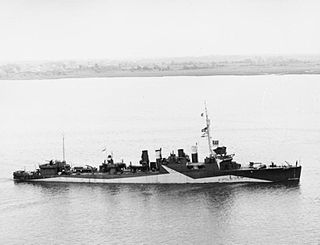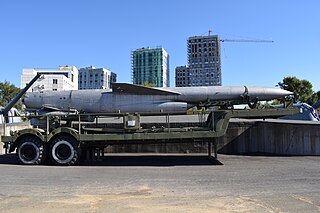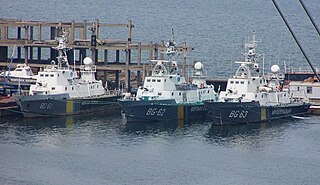Related Research Articles
This is a list of aviation-related events from 1941:

USS Herndon (DD-198) was a Clemson-class destroyer in the United States Navy. Herndon served in the United States Coast Guard as CG-17. She was later transferred to the Royal Navy as HMS Churchill and still later to the Soviet Navy as Deyatelny.

The Soviet Navy's Project 611 were one of the first Soviet post-Second-World-War attack submarines. They were similarly capable to the American GUPPY fleet-boat conversions. They were a contemporary of the Whiskey-class submarines and shared a similar sonar arrangement. Like most conventional submarines designed 1946–1960, their design was influenced by the German World War II Type XXI U-boat.

The P-500 Bazalt is a turbojet-powered, supersonic cruise missile used by the Soviet and Russian navies. Its GRAU designation is 4K80 and its NATO reporting name is SS-N-12 Sandbox, its upgraded version being the P-1000 Vulkan AShM SLCM.

Qinghaihu is a Komandarm Fedko-class replenishment oiler of the People's Liberation Army Navy (PLAN). Ukraine sold the incomplete ship in 1992 to the People's Republic of China, where it was completed and commissioned in 1996.

The Poti class was the NATO reporting name for a group of anti-submarine warfare (ASW) corvettes built for the Soviet Navy. The Soviet designation was Project 204 small anti-submarine ships. These ships were the first Soviet warships powered by gas turbine engines; two propellers were mounted in tunnels to give a very shallow draught. A twin 57 mm (2 in) gun mounting provided self-defence. Three ships of the class were exported to Romania and six to Bulgaria during the Cold War. By 2008, all ships of the class were no longer extant.
Project 1252 'Izumrud' were a group of three minesweepers built for the Soviet Navy in the late 1960s. The ships were a glass-reinforced plastic (GRP)-hulled version of the preceding wooden-hulled Vanya class. They were intended to be a prototype of an advanced design, instead the Soviet Navy returned to wooden-hulled minesweeper construction with the following Sonya class. Of the three minesweepers, one was lost in an explosion in 1989 and the fate of the other two is unknown.

The Stenka class is the NATO reporting name for a class of patrol boats built for the Soviet Navy, KGB Border Troops and Soviet Allies. The Soviet designation was Project 205P Tarantul. The boats are an anti-submarine patrol version of the Osa-class missile boat.

The Ugra class was the NATO reporting name for a group of seven submarine tenders built for the Soviet Navy in the late 1960s. The Soviet designation was Project 1886. One further ship was built for the Indian Navy to a modified design. The ships were intended to provide afloat support for Soviet submarines, including supplies, water, torpedoes, fuel, and battery charging; minimal repair facilities, and were often employed as flagships/command ships for submarine squadrons. A subclass, the Borodino class, of two ships were constructed for use as training ships and lacked missiles and the ability to support submarines. Instead, the Borodino class had classrooms and training facilities.

Lützow was a heavy cruiser of Nazi Germany's Kriegsmarine, the fifth and final member of the Admiral Hipper class, but was never completed. The ship was laid down in August 1937 and launched in July 1939, after which the Soviet Union requested to purchase the ship. The Kriegsmarine agreed to the sale in February 1940, and the transfer was completed on 15 April. The vessel was still incomplete when sold to the Soviet Union, with only half of her main battery of eight 20.3 cm (8 in) guns installed and much of the superstructure missing.

Razumnyy was a 1135 Burevestnik-class Large Anti-Submarine Ship or 'Krivak' class frigate that served with the Soviet and Russian Navies. Launched on 20 July 1973, the vessel operated as part of the Pacific Fleet, as a dedicated anti-submarine vessel, with an armament built around the Metel Anti-Ship Complex. The vessel undertook a number of tours, visiting the People's Democratic Republic of Yemen and India. The ship was decommissioned on 16 March 1998 and subsequently disarmed ready to be broken up before the end of the year.

Zadornyy was a Project 1135 Burevestnik-class guard ship or Krivak-class frigate that served with the Soviet and Russian Navies. Displacing 3,200 tonnes full load, the vessel was built around the Metel anti-submarine missile system. Zadornyy was launched on 25 March 1979 in Leningrad, the last of the class to be built by the A.A. Zhdanov shipyard, and served with the Northern Fleet. After taking part in exercises Avangard-81, Sever-81 and Okean-83, and cruising as far as Havana, Cuba, the vessel was upgraded between 11 June 1990 and 23 May 1995 with missiles that added anti-ship capability. While serving with the Russian Navy, the ship took part in joint exercises with frigates of the Royal Navy, including a commemoration of the first Arctic convoy of the Second World War with HMS Campbeltown. After more than twenty-five years service, the ship was decommissioned on 3 December 2005.

Deyatelnyy was a Soviet Navy 1135 Burevestnik-class Large Anti-Submarine Ship or Krivak-class frigate. Displacing 3,200 tonnes full load, the vessel was built around the Metel anti-submarine missile system. Launched on 6 April 1975, Deyatelnyy served with the Black Sea Fleet and, as well as Bulgaria in the Black Sea, spent the next two decades travelling as far as the Mediterranean Sea to visit ports in North Africa for cultural reasons and to improve relations between the Soviet Union and other nations, For example, in 1981, the ship was the first Soviet vessel for more than ten years to visit Libya. In 1987, the vessel was used to test a new missile for the Metel system that added anti-ship capability. The ship was taken out of service for repair and modernisation in 1991. However, lack of funding meant that, instead, Deyatelnyy was decommissioned on 10 June 1995 and broken up.

Svirepyy was a Project 1135 Burevestnik-class Large Anti-Submarine Ship or Krivak-class frigate that served with the Soviet Navy. Displacing 3,200 tonnes full load, the vessel was built around the Metel anti-submarine missile system. The ship was launched on 27 January 1971 in Kaliningrad and joined the Baltic Fleet. The ship's service was not restricted to the Baltic Sea and instead travelled widely, visiting a number of foreign friendly ports during the next two decades, including Gdynia, Poland and Havana, Cuba. Svirepyy was designated a Guard Ship from 1977 as Soviet strategy changed to one creating safe areas for friendly submarines close to the coast. However, the ship continued to travel widely, including trips to the capital cities of both Finland and Tunisia as well as Rostock in East Germany. Svirepyy was transferred to the Russian Navy after the dissolution of the Soviet Union, but did not last long before being decommissioned on 30 June 1993 and subsequently broken up.

Razyashchiy was a Project 1135 Burevestnik-class Large Anti-Submarine Ship or Krivak-class frigate of the Soviet Navy. Displacing 3,200 tonnes full load, the vessel was built around the Metel anti-submarine missile system. Launched on 22 July 1974, Razyashchiy joined the Pacific Fleet of the Soviet Navy. While serving in the Arabian Sea, in 1983, Razyashchiy suffered minor hull damage from colliding with the destroyer USS Fife while approaching a US fleet. The ship also undertook visits to Port Louis, Mauritius, and Danang, Vietnam, to, among other objectives, enhance the relationships between these countries and the Soviet Union. In 1991, the vessel was transferred to the newly-formed Russian Navy. After nearly twenty years of service, however, Razyashchiy was in a poor state and so was decommissioned on 29 October 1992 and sold to be broken up on 6 October 1994.

Grozyashchiy or Grozyashchy was a 1135M Burevestnik-class guard ship, or frigate with the NATO reporting name 'Krivak-II', that served with the Soviet and Russian Navies. Launched on 7 February 1977, the vessel operated as part of the Pacific Fleet as an anti-submarine vessel, with an armament built around the Metel Anti-Ship Complex. Grozyashchiy undertook a number of visits to nations friendly to the Soviet Union, including Angola, Mauritius, Mozambique and Sri Lanka. The ship also formed part of the Soviet presence during the Sino-Vietnamese conflicts and visited Da Nang, Vietnam, in the October 1981. With the dissolution of the Soviet Union, Grozyashchiy joined the Russian fleet, but lack of funding meant that a planned repair in 1992 was not completed and instead the vessel was decommissioned on 13 February 1995 and sold to be broken up.

Pytlivyy is a Project 1135M Burevestnik-class Guard Ship or 'Krivak II'-class frigate that served with the Soviet and Russian navies. Launched on 16 April 1981, the vessel was designed to operate as an anti-submarine vessel, with an armament built around the Metel Anti-Ship Complex. Part of the Black Sea Fleet, the vessel undertook friendly visits to Algeria, Greece, and Malta, at the last hosting a meeting between the Soviet and US leaders Mikhail Gorbachev and George H. W. Bush. In 1991, the ship was transferred to the Russian Navy following the dissolution of the Soviet Union, and, following a three-year repair, took part in a number of joint exercises with other navies. For example, 2003 found the vessel operating alongside the Indian Navy and 2005 with the Italian Navy. In 2006, Pytlivyy took part in NATO's Operation Active Endeavour and subsequently formed part of Russia's presence in the Mediterranean Sea in the war against terrorism in the early 21st century. The ship also operated as part of the Russian intervention in the Syrian civil war. As of 2021, Pytlivyy remains in service.

Rezvyy or Rezvy was the lead Project 1135M Burevestnik-class Guard Ship or 'Krivak II'-class frigate. Launched on 30 May 1975, the vessel was designed to operate in an anti-submarine role in the Soviet Navy, with armament built around the Metel Anti-Ship Complex. Part of the Northern Fleet, the vessel undertook operations in the Atlantic Ocean, including visits to Congo and Cuba, and participating in the Atlantic-84 major naval exercise in 1984. After a major refit between 1989 and 1992, Rezvyy was recommissioned into the Russian Navy. The ship continued to travel, visiting Norway in 1993. After more than twenty-five years service, Rezvyy was decommissioned on 1 June 2001 and subsequently broken up.

Neukrotimyy was a Project 1135M Burevestnik-class Guard Ship or 'Krivak II'-class frigate that served with the Soviet and Russian Navies. The vessel was known as Komsomolets Litvyy between 1987 and 1990. Launched on 17 September 1977, Neukrotimyy was designed to operate as an anti-submarine vessel with the Baltic Fleet, using an armament built around the Metel Anti-Ship Complex. The vessel undertook many visits to other countries outside the Soviet Unions, including Angola, East Germany, Nigeria and Poland. Following the dissolution of the Soviet Union, in 1991, the ship was transferred to the Russian Navy and continued to travel to countries like the Netherlands. Despite being accidentally holed in 2005 and being badly burnt in a fire in 2008, Neukrotimyy remained the penultimate of the class to remain in service, finally being decommissioned on 29 June 2009.
References
- ↑ North Atlantic Treaty Organization (12 February 1968). "I-C". Current Soviet Bloc Electronic Equipment - Shipborne (Report). p. 25. MC 0262/A/67.
- ↑ Wertheim, Eric (2013). The Naval Institute Guide to Combat Fleets of the World: Their Ships, Aircraft, and Systems (16 ed.). Annapolis, Maryland: Naval Institute Press. p. 108. ISBN 978-1591149545.